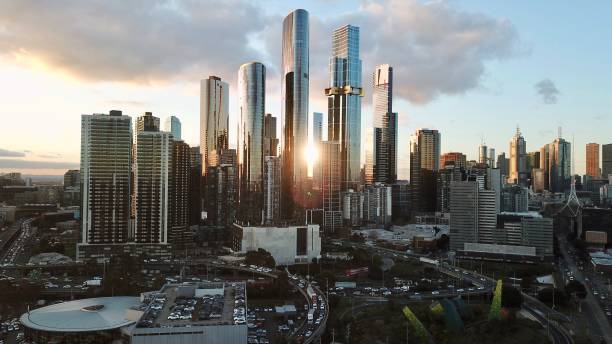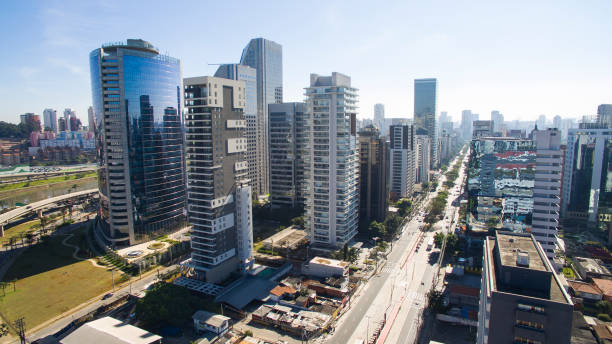How To Describe A City In Writing (21 Important Steps)
Describing a city in writing is a profound act of literary alchemy, where words become the brushes and the canvas upon which the urban landscape is painted.
It is a journey through the senses, a symphony of sights, sounds, and emotions that invites readers to traverse the bustling streets and towering skyscrapers of a metropolis within the pages of a book.
As writers, we are not mere storytellers but architects of immersive worlds, tasked with the delicate mission of transforming the cityscape into a living, breathing character within our narratives.
In this exploration, we delve into the art of not just portraying the physicality of a city but of capturing its essence, personality, and the profound impact it exerts on the characters and stories that unfold within its embrace.
This guide will unravel the intricacies of describing a city in writing, offering insights into research, sensory imagery, symbolism, and the profound emotional resonance that can be achieved when the city itself becomes a vital protagonist in our tales.
How To Describe A City In Writing
Describing a city in writing involves painting a vivid picture with words, capturing its essence, and conveying its unique character. Here’s a step-by-step process to help you do that effectively:
Choose Your City
Select the city you want to describe. It could be a place you’ve visited, lived in, or one that you’re researching.
Research and Observation
Gather information about the city’s history, culture, landmarks, and notable features. If possible, visit the city to observe its sights, sounds, and atmosphere firsthand.
Create an Outline
Before you start writing, make an outline to organize your thoughts. Consider what aspects of the city you want to highlight, such as its architecture, people, cuisine, or climate.
Engage the Senses
When describing the city, appeal to the reader’s senses. Describe what the city looks like, sounds like, smells like, tastes like, and feels like. This creates a more immersive experience.
Start with an Introduction
Begin your description with a captivating introduction that sets the scene and captures the reader’s attention. Mention the city’s name, location, and any notable facts.
Describe the Geography and Setting
Detail the city’s geographical location, including its surroundings – whether it’s nestled in the mountains, sprawled on the coast, or situated in a desert.
Architectural Features
Describe the city’s architecture, highlighting iconic buildings, bridges, or skyline. Explain their historical or cultural significance.
Cultural and Historical Context
Provide context by discussing the city’s history, its role in any historical events, and its cultural diversity. Mention any museums, monuments, or heritage sites.
Local Cuisine and Food Culture
Talk about the local cuisine and dining culture. Mention any famous dishes, street food, or culinary traditions that define the city.
Local Residents
Describe the people who call the city home. Talk about their lifestyles, customs, and the unique characteristics that make them distinct.
Climate and Weather
Discuss the city’s climate, seasons, and weather patterns. How do these factors affect daily life and the city’s atmosphere?
Green Spaces and Nature
If applicable, mention parks, gardens, and any natural elements within the city. Describe how these spaces contribute to the city’s ambiance.
Transportation and Infrastructure
Explain the city’s transportation systems, such as buses, subways, or iconic forms of transit. Also, note the quality of the roads and infrastructure.
Economic and Commercial Activities
Discuss the city’s economic activities, major industries, and commercial areas. Mention any famous shopping districts or markets.
Cultural Events and Entertainment
Highlight any cultural events, festivals, theaters, or entertainment venues that contribute to the city’s vibrancy.
Societal Atmosphere
Describe the general atmosphere and mood of the city. Is it bustling and fast-paced, laid-back, or somewhere in between?
Local Lingo and Slang
If there are unique words, phrases, or slang associated with the city, incorporate them to give your description authenticity.
Conclude with an Impression
Summarize your description with a final impression of the city. What makes it special, unique, or worth visiting?
Editing and Proofreading
Revise and edit your description for clarity, conciseness, and coherence. Ensure your writing flows smoothly.
Peer Review
If possible, have someone else read your description to get feedback and make improvements.
Final Touches
Add any final touches, such as descriptive metaphors, similes, or poetic language to make your writing more engaging.
Remember that the key to effective city description is to transport your reader to the city, allowing them to see, feel, and experience it through your words.

Pre-Writing Preparation
Pre-writing preparation is the compass that guides a writer through the uncharted territory of creativity. It’s the backstage pass to the grand spectacle of storytelling, a moment of quiet contemplation before the words burst onto the stage.
Like an architect surveying a blank canvas of land before sketching the blueprint of a majestic city, a writer delves into the city of their narrative.
Pre-writing is where facts marry imagination, and where intentions meet the canvas of possibilities.
It’s a symphony conductor fine-tuning their orchestra before the first note resonates through the concert hall.
In this sacred prelude to the literary journey, authors don the hats of historians, psychologists, and artists, sifting through the sands of time, human behavior, and creative expression to lay the foundation for a city that will exist solely on the pages of their story.
Research the city
Researching the city is akin to embarking on an exhilarating expedition through the annals of history and the vibrant tapestry of contemporary life.
It’s the literary archaeology that unearths the city’s secrets, laying bare its character, aspirations, and idiosyncrasies.
By delving into the rich chronicles of its past, we uncover the hidden gems of culture and tradition that have shaped the city’s essence.
This meticulous exploration brings to light the landmarks, the legends, the whispers of forgotten tales, and the bustling life that courses through its veins today.
It’s a treasure hunt for anecdotes, anecdotes that may be as old as the city itself or as fresh as the morning dew on a bustling market square.
Researching the city is the essential act of donning the shoes of an urban detective, ready to unearth the stories that will breathe life into the written metropolis.

Determine the purpose of your description
Before the quill touches the parchment or the keyboard springs to life, there exists a pivotal juncture in the creative process: determining the purpose of your city’s description. It’s the compass that will set the direction for your narrative ship.
Are you seeking to merely set the stage, offering a vivid backdrop for your characters’ escapades, or is your aim to craft an atmosphere so immersive that it becomes a character in itself, an inseparable part of the story’s essence? Perhaps your purpose is to evoke emotions, to make your readers feel the pulse of the city as if it were their own heartbeat.
Identifying this purpose is akin to selecting the lens through which your readers will view the cityscape you’re painting.
It’s a conscious decision that shapes the tone, the depth, and the emotional resonance of your narrative, ensuring that each brick and cobblestone serves a purpose beyond mere aesthetics.
Sensory Imagery
Sensory imagery is the alchemical magic that transmutes words into sensations, transporting readers to worlds they’ve never physically traversed.
It’s the symphony of sight, sound, scent, touch, and taste meticulously woven into the fabric of storytelling.
With the stroke of a pen or the click of a keyboard, writers can paint vivid, three-dimensional cityscapes, enabling readers to not just see the towering spires, but to hear the whispers of history in the wind, smell the sizzle of street food, and feel the cobblestones beneath their fingertips.
Sensory imagery is the key that unlocks the secret door to a parallel universe, where words are not just symbols, but portals to experiences that transcend the page and ignite the imagination.
Personification
Personification is the literary sorcerer’s wand, the enchanting act of breathing life into the inanimate, a bewitching dance between imagination and language.
It transforms ordinary objects and abstract concepts into vibrant characters, imbued with human traits, emotions, and intentions.
It’s like giving the city a soul, an identity, a heartbeat that resonates with the reader’s own.
The bustling streets become animated veins, the skyscrapers become sentient giants, and the city itself, a living, breathing entity with its own stories to tell.
Through personification, the city doesn’t just exist as a backdrop; it becomes a vital player in the grand theater of the narrative, revealing its own secrets and desires, making it a character as intricate and unforgettable as any human protagonist.
Breathing life into the city
Breathing life into the city is the novelist’s act of rendering urban landscapes with the same intricate care as sculpting characters.
It’s a masterful stroke of the pen that infuses the concrete and steel with pulse and personality.
As a writer, you become an urban alchemist, conjuring a metropolis teeming with life, its streets a symphony of voices, its architecture a silent testimony to the aspirations and dreams of generations.
Through vivid descriptions and narrative insights, the city takes on a heartbeat of its own, influencing the emotions and decisions of the characters that dwell within its embrace.
It becomes a silent, omnipresent character, both nurturing and challenging, shaping the story’s very fabric.
Breathing life into the city is more than description; it’s the gift of a dynamic, breathing entity, a vibrant soul entwined with the tale you’re weaving, ensuring it resonates with readers long after the last page is turned.

Describing the city as if it were a character
Describing the city as if it were a character is a literary feat that invites readers to forge a personal connection with the urban landscape.
By endowing the city with human attributes, quirks, and emotions, it becomes more than a backdrop; it transforms into a dynamic entity that engages and resonates on an emotional level.
The city’s streets pulse with energy, its architecture carries the weight of history, and its mood shifts like the temperament of a well-drawn character.
Just like a person, the city can be enigmatic, nurturing, mysterious, or obstinate. It possesses a story, an identity, and, at times, a silent conversation with the story’s protagonists.
Describing the city in this way offers a unique lens through which readers can engage with the narrative, allowing them to feel the city’s heartbeat alongside the characters, making it a compelling and multidimensional presence within the story.
How the city interacts with its inhabitants
The intricate dance between a city and its inhabitants is a dynamic narrative of relationships, influence, and reciprocity. A city is not a passive stage but an active player in the lives of those who dwell within its bounds.
It weaves an intricate tapestry of encounters, juxtaposing moments of connection and disconnection, solitude and camaraderie.
It can be a demanding lover, challenging its residents to adapt and evolve, or a steadfast friend, providing a backdrop to their daily adventures.
The city’s streets and architecture absorb the stories and emotions of its people, silently witnessing their triumphs and tribulations.
Just as the city leaves its indelible mark on its inhabitants, the people, in turn, shape the city’s character through their actions and narratives.
This symbiotic relationship between city and inhabitant is a rich source of storytelling, a reflection of the ever-evolving, intricate connection that defines the human experience in urban landscapes.
Historical and Cultural Context
Historical and cultural context is the magical time machine that transports readers to bygone eras, illuminating the present with the shimmering torch of the past.
It’s a grand tapestry woven with the threads of events, beliefs, and traditions, a tapestry that unfurls before the reader, connecting the dots of history and culture in a mesmerizing narrative.
Through it, we unearth the buried treasures of forgotten dynasties, witness the rebellious spirit of revolutions, and partake in the timeless rituals of diverse societies.
It’s the secret code that unlocks the city’s deeper layers, revealing the whispers of the past in every cobblestone and skyline, and the vibrant traditions that breathe life into its streets today.
Historical and cultural context is the literary passport that guides us through the city’s ever-evolving story, making the past a vivid companion to the present, and infusing the narrative with a profound sense of time and place.
Character Reflection
Character reflection is the author’s mirror, the poignant moment when characters gaze into their own souls and reveal the intricate tapestry of their thoughts, desires, and vulnerabilities.
It’s a literary confession, the exposed nerve that makes characters not only relatable but irresistibly human.
Just as we ponder our own reflections in a mirror, characters delve into the depths of their experiences, confronting their fears, ambitions, and the truths they dare not speak.
In this intimate journey of self-discovery, characters may find enlightenment or become entangled in the labyrinth of their own complexities.
It is in these reflections that readers discover the beating hearts behind the words, forging connections that bridge the realms of fiction and reality.
Character reflection is the art of capturing the essence of the human spirit, inviting readers to not only observe but participate in the beautiful, tumultuous, and profound voyage of self-exploration.
Describing how the city affects characters’ emotions
The city, like a skilled conductor, orchestrates a symphony of emotions within its inhabitants. It can be an emotional tempest, where the ceaseless urban cacophony elicits anxiety and restlessness, or a soothing lullaby, offering solace amidst the bustling chaos.
The city’s changing moods can sweep characters into moments of exhilaration as they scale skyscrapers or plunge them into melancholy as they wander through abandoned alleyways.
It infuses their souls with a unique rhythm, mirroring their own emotional crescendos and decrescendos. Characters may find inspiration in its vibrant street art or harbor nostalgia beneath its time-worn lampposts.
The city is a silent confidant, echoing the joys, sorrows, and introspective contemplations of those who traverse its winding streets.
As a writer, exploring how the city affects characters’ emotions is akin to weaving an intricate dance between setting and psyche, unveiling the profound symbiosis between the urban landscape and the human heart.

Influences on the characters’ personalities and actions
The city, a living, breathing entity, serves as an invisible hand shaping the clay of its inhabitants’ personalities and actions. Its bustling streets, architectural marvels, and vibrant neighborhoods are like an intricate mosaic that influences character development.
The city can breed ambition, instilling a fierce determination in its residents as they navigate its competitive landscapes. Simultaneously, it can nurture a sense of community, prompting individuals to extend kindness and camaraderie to their neighbors.
The very rhythm of life in the city can turn people into fast-paced, quick-thinking go-getters or patient, adaptable souls who’ve mastered the art of survival.
It can provoke rebellion or inspire innovation, fostering traits like resilience, resourcefulness, and adaptability.
The city’s stories, both whispered and shouted, often become the tales that shape a character’s values and ambitions.
In this dynamic, reciprocal relationship, the city becomes a character itself, intricately intertwined with the very essence of those who reside within its bounds.
Metaphors and Symbols
Metaphors and symbols are the elusive keys that unlock the treasure chest of meaning in writing, turning words into a labyrinth of hidden gems waiting to be discovered.
Like whispered secrets in a crowded room, metaphors invite readers to see beyond the literal, to peel away the layers of reality, and dive into the depths of imagination.
Symbols, on the other hand, are the archetypal lighthouses that guide readers through the darkest narrative storms, offering profound insight into universal truths.
Together, they transform the mundane into the magical, the tangible into the ethereal. In the hands of a skillful writer, metaphors and symbols become the alchemical catalysts that transmute words into feelings, connecting the author’s vision with the reader’s heart.
They are the literary constellations that adorn the writer’s night sky, each dot of brilliance igniting a universe of interpretation, ensuring that every word is more than it seems, concealing worlds within worlds, inviting readers to lose themselves in the infinite labyrinth of storytelling.
Symbols that represent the essence of the city
Symbols, like hidden gems scattered throughout a treasure trove, represent the very essence of the city, encapsulating its identity, history, and collective spirit. Each symbol is a sentinel, standing as a silent witness to the city’s past and its evolving present.
These iconic emblems embody the aspirations and stories of its people, resonating like a timeless melody.
Whether it’s an architectural marvel, a revered monument, or a simple street corner cafe, these symbols become the threads that weave together the city’s unique narrative, serving as a tapestry of memory and significance.
They are more than just objects; they are living metaphors that reflect the city’s soul, serving as touchstones for the emotions and experiences that define life within its bounds.
As writers, these symbols offer us a powerful means to convey the city’s depth, invoking a collective consciousness that binds readers and characters to the heartbeat of the urban landscape.
Narrative Perspective
Narrative perspective is the kaleidoscope through which stories unfold, a prism that shapes the colors and contours of our literary worlds.
It’s the writer’s ultimate sleight of hand, the magic that lets us slip into the shoes of characters, hover like an invisible observer, or wield god-like knowledge over the tale.
First-person perspective invites readers to delve deep into a character’s psyche, becoming an intimate confidant to their thoughts and feelings.
Third-person offers an all-seeing eye, revealing a broader tapestry of events and emotions, while omniscient perspective allows us to traverse time and space, connecting the dots of the narrative’s universe.
Narrative perspective isn’t just a technical choice; it’s a transcendental experience, a shifting of dimensions that immerses us in a story’s soul.
Writers play the role of cosmic architects, selecting the lens through which readers perceive their imaginative worlds, making narrative perspective the gateway to limitless storytelling possibilities.

Progressive Description
Progressive description is the art of storytelling akin to an unfolding flower, revealing its petals one by one. It’s the literary equivalent of a treasure hunt, a tantalizing journey that entices readers to follow the breadcrumb trail of details, layer by layer.
This technique isn’t just about depicting a static cityscape but rather about crafting a dynamic, evolving narrative where every detail unfurls at the perfect moment, much like a seasoned magician revealing tricks in a carefully choreographed show.
It keeps the reader on their toes, inviting them to savor each revelation and fostering a sense of wonder and anticipation.
Progressive description is the storyteller’s symphony, building to a crescendo, leaving readers in rapturous suspense until the final notes of the narrative resound in their imagination, making it a literary technique that turns mere words into a captivating journey of discovery.
Building the city’s image progressively
Building the city’s image progressively is akin to a masterful brushstroke that gradually unveils the vivid portrait of an urban landscape.
It’s a process of strategic revelation, designed to engage readers’ senses and curiosity step by step, much like a captivating mystery slowly unraveling its secrets.
As the narrative unfolds, the city’s details emerge organically, creating a gradual immersion that mirrors real-life exploration.
This technique allows readers to forge a deeper connection with the setting, as if they are uncovering the city’s character, one layer at a time.
It kindles anticipation and fosters a sense of attachment to the story’s backdrop, making the city not just a static canvas but a living entity that breathes alongside the characters.
In the hands of a skillful writer, building the city’s image progressively transforms the setting into a dynamic, integral part of the narrative, ensuring that it resonates in the reader’s imagination long after the final page is turned.
Emotional Resonance
Emotional resonance in storytelling is the echo that lingers in a reader’s heart long after the book is closed. It’s the indelible mark left by words that can make us laugh, cry, or ponder life’s enigmas.
Like an ethereal connection between the author and the reader, emotional resonance transcends the pages, making characters and their journeys feel vividly real.
It’s that unspoken understanding, the feeling that the author has bared their soul on the page, and we, as readers, have been seen and understood in return.
Whether it’s the poignancy of a character’s triumph, the bittersweet farewell, or the deep well of empathy for their struggles, emotional resonance is the essence of storytelling’s magic, leaving us irrevocably changed, as if we’ve not just read a book, but lived it.
Frequently Asked Questions (FAQ) about How To Describe A City In Writing
What is the purpose of describing a city in writing?
Describing a city in writing serves various purposes, such as creating a vivid mental image, promoting tourism, conveying the city’s unique character, or capturing the essence of a place for literature or travel guides.
Do I need to visit the city to describe it effectively?
While firsthand experience is beneficial, it’s not always necessary. You can conduct research, gather information, and use your imagination to describe a city effectively.
What aspects of a city should I focus on when describing it?
Focus on various aspects, including the city’s geography, architecture, culture, history, people, cuisine, climate, and local attractions.
How can I make my city description more engaging to readers?
Engage readers by using descriptive language, appealing to their senses (sight, sound, smell, taste, touch), and sharing personal anecdotes or stories related to the city.
How do I balance facts and creativity when describing a city?
Balancing facts and creativity is essential. Use facts to provide context and accuracy, and then weave in creative language and storytelling to make the description engaging.
Are there any common mistakes to avoid when describing a city in writing?
Avoid clichés, overusing adjectives, being overly biased, and neglecting to edit and proofread your work. Also, be sensitive to cultural nuances and avoid stereotypes.
What is the ideal length for a city description?
There’s no fixed length, but it should be long enough to capture the city’s essence without becoming overly verbose. It can range from a few paragraphs to several pages, depending on your purpose.
Can I include personal opinions and emotions in a city description?
Yes, sharing your personal opinions and emotions can add authenticity to your description, as long as you balance them with factual information.
How can I make my city description stand out from others?
Make your description unique by highlighting less-known aspects of the city, using vivid language, and adding a personal touch or perspective that sets it apart from typical descriptions.
Can I use online resources or travel guides for information when describing a city?
Absolutely, online resources, travel guides, and books about the city are valuable sources of information to enhance the accuracy and depth of your description. Just be sure to credit your sources when necessary.
Conclusion
In the tapestry of storytelling, the city stands as a vibrant thread, woven intricately into the fabric of our narratives.
Describing a city in writing is more than a creative task; it’s an invitation for readers to embark on journeys of exploration and emotion, guided by our words and immersed in the sensory world we’ve constructed.
As we conclude this guide on how to describe a city in writing, we must remember that cities are not static backdrops but dynamic, breathing entities that influence the characters and narratives within them.
Through careful research, evocative sensory imagery, personification, and rich symbolism, we can paint cityscapes that resonate deeply with readers, fostering an emotional connection that extends far beyond the confines of the page.
The city, with its towering spires and bustling streets, becomes not just a setting but a living, breathing character, an integral part of our stories.
So, let us continue to craft cities that speak to the soul, forging narratives that transport readers to distant urban landscapes, allowing them to lose themselves in the intoxicating hum of the metropolis and, in doing so, to discover the magic of storytelling in its fullest form.






